The Beamish Museum is an open-air museum replicating a northern town of the early 20th century. The museum's guiding principle is to preserve an example of everyday life in urban and rural North East England at the climax of industrialisation. It depicts chiefly Victorian buildings in an evolved urban setting of 1913.
The museum was the vision of Frank Atkinson who was the museum's founder and first director. Having visited Scandinavian folk museums in the early 1930s, Atkinson was inspired to create an open museum for the North East. He adopted a policy of 'unselective collecting' - 'you offer it to us and we will collect it'. The people of the region responded with donations of all kinds ranging from everyday objects to steam engines and shops, filling an entire army camp of 22 huts.
One of the donations was this bus which was one of the first things we saw during our visit.
A closer view
We decided to take the electric tram
We were the only passengers. My companions went to the upper deck while I decided to stay downstairs which resulted in a very interesting conversation with the conductor
On our way to the village we passed the mine, another exhibit at the museum, which unfortunately we knew we would not have enough time to visit this time, and then we arrived at the village.
Our first stop was the Masonic Temple
which was originally in Sunderland.
The bank was next, Barclays
where components from Southport and Gateshead were used.
I liked the wallpaper.
A brewers' van was parked outside the bank when we came out
and we moved on to the Jubilee Confectioners
and sugar lovers' paradise (note the wonderful ceiling)
the displays made our mouths water but we resisted and did not buy anything.
We were able to visit the workshop which is adjacent to the shop. The confectioner was in the process of making sweets - these long strips are cut into small rounds. We helped ourselves to the samples that were available for visitors to take
on the wall you can see the various cylinders that are used to make the different shapes of sweets.
Our next stop was the Post Office
which also sold sweets and newspapers.
And then it was time to go to the pub
no customers, because it was early in the morning.
We then visited some house in the Victorian terrace (from Gateshead)
Our first stop was the house of the teacher of music
No musical instruments but we had a look at the parlour
and one of the bedrooms
It was then time to pay a visit to the dentist. We were pleasantly surprised to see that the dentist was a woman. When we mentioned this she explained that, given the times she lived in, she'd had to make a choice: marriage or her career, and she decided to choose her career.
The gas cylinders looked scary, particularly after she explained that the amount of gas administered was completely ad hoc. So ad hoc in fact, that one patient died every two weeks. The back stairs were used to take the bodies away, so as not to frighten the rest of the patients.
The dentist demonstrated how the gas was administered. The drill was powered by foot. It took approximately half an hour to do a small filling and because the drill would get very hot, long breaks were necessary.
We also visited the nursery
the parlour
the kitchen
and the bathroom. The dentist was the richest person in the village and her house was the only one with an indoor bathroom.
The bandstand (from Gateshead) is in the middle of the green which we had to cross on our way to
the tearooms. A vast space, and no wonder, they get so many visitors in the summer. When we visited it was relatively empty though.
We also went to see the dining hall which was out of use when we visited
but we loved the booths and their folding seats.
It was then time to visit the Co-op across the road
First stop, the Drapery Department
I loved the advertising chair - it's amazing what people donated to the museum
then the grocery department - note the coffee grinder.
The garage is huge
selling all kinds of oils and parts
but it was the vintage cars that we particularly appreciated
as well as the motor bikes.
The bakery was next
the shop
the working area where the two bakers were busy
and we loved the machine where they mix the dough.
A quick walk to the train station, and by the tracks we saw this advertisement
and then it was time to take the tram for our return.


















































Fascinating, thank you. The dentist was a revelation to me.
ReplyDeleteYes, the dentist was the best bit. That woman was very good - we enjoyed listening to her. I decided against using the photos of all the implements, the false teeth, the pliers....
DeleteI also enjoyed watching the sweets being made.
Olga, the museum is huge, and it includes lots of other areas of interest. I am looking forward to seeing the mine next time we go.